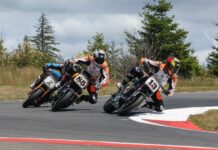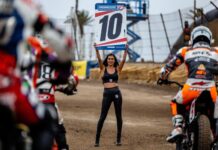In the groove
A flat track race looks pretty simple when you’re watching from the stands: Go fast, turn left, don’t crash, go faster than the other riders and cross the finish line before anyone else.
But nothing is ever really that simple, being that guy who gets to the checkered flag first—especially in the Twins class of the recently-revived American Flat Track series—takes something special. The riders who compete at the top level are all highly-skilled athletes on purpose-built machines that have spent years developing their talent.
As spectators, we watch the race, cheering on our favorite riders, teams, or brands. The action is fast, loud and intense. Once the green flag drops an angry pack of 18 motorcycles rushes into the first turn, each rider fighting to get through ahead of everyone else; it’s hard to believe any rider will make it unscathed. But they do—usually—most of them, anyway.

We get excited as two, three, or sometimes even four riders swap position for the lead in a back and forth dance of speed and strategy for 25 laps until one outmaneuvers the rest of the pack, sometimes not until inches before the checkered flag, to take victory. We grip our seats or beers tight when we witness a nasty crash and relax only when the downed rider finally gets back up on his feet and gives the crowd a wave.
I’m one of the recent converts to flat track racing. I’ve raced motorcycles at Daytona and other Florida tracks and now do safety work. I know what I’m looking at when watching road racers. But I only had a vague understanding of what these guys do when racing in the dirt.
Recently I had a rare opportunity to talk with Harley-Davidson’s factory team—Brandon Robinson, Sammy Halbert and Jared Vanderkooi—to ask them about the skills and strategies of flat track racing. All three of them emphasized the same thing—the rider who reads the track the best and can adapt his bike to constantly-changing conditions is favored to win.
“The track is always changing,” Halbert explains, “which makes setup so crucial. It’s such a challenge to keep up with; the track may start out slow and get faster throughout the day as it gets ridden and packed down so you have to chase it with gearing. Then they may groom it and water it down so it gets slippery and slick and slows down again. Then we need to change gearing, suspension and tires to stay competitive.”

Vanderkooi adds: “It’s tough because there’s so many groups that go out between our sessions. Every time we go out it’s changed; when we come off the track we debrief and try to make the best call for the next session.”
With 18 tracks on the schedule for the season, each takes a different strategy. The Short Tracks and Half-Miles are usually car tracks with a clay surface—but the clay differs among regions. The clay in Georgia is different than in New York or California. Some will be as hard and smooth as a paved road course; others will be loose and slippery, or maybe even rough and chunky. The mile-long races are often on horse racing tracks with a loose surface of pea gravel or crushed rock—called a “Cushion Track.” And the TT courses, which include right-hand turns and a jump, are temporary purpose-built tracks made with trucked-in dirt that require a totally different setup and race strategy. On a Short Track the laps can be as quick as 20 seconds, a Mile Track will be twice that at 40 seconds; Half-Miles and TT Tracks can run between the mid-20 to mid-30-second range.
There’s usually only one ideal line around the shorter tracks and a “Blue Groove” shows that path where the traction is best; passing often means bumping someone else off the groove. Halbert—who earned his nickname, “Slammin’ Sammy” through his aggressive riding—says, “Bumping is just one of those things. When you come up on the inside and you commit, and then all of a sudden there’s not enough room and you’re going to hit someone, you just hold your bike so when do hit you don’t go down. Of course, when you dish it out you have to be prepared to take it too,” he adds with a chuckle before saying, “On the Miles though, you try to give a guy room and don’t bump at over a hundred miles an hour.” Top speed on some mile tracks can be as fast as 140 mph.

The strategy is different on the miles. The softer “cushion track” allows for riders to choose different lines, and passing usually happens at the end of the long straight where the lead bike is pulling the bike behind in his draft. No rider wants to be leading another bike into the final turn on the last lap of a race—it’s almost always a guarantee of a second-place finish because the bike behind will get an additional few mph from the draft and pull around in the last 100 feet before the checkered flag comes out. Always an exciting finish!
The Miles are Robinson’s favorite tracks: “I choose my gearing so it’ll hit the rev limiter and set my speed at the end of the straight before turning in, then I’ll be hard on the throttle while riding the rear brake to keep the bike settled all through the turn.” He’s easy to spot at night races by the glowing red of the rotor on his rear wheel as he power slides through the corner and shoots down the straight, all to do it again 10 seconds later.
Riders use a steel shoe, or hotshoe, while sliding through the corners. “We put a steel shoe on our left boot so it’ll glide across the ground,” said Vanderkooi. “It’s mostly for reference and to keep our balance. But sometimes if you are about to crash you can pick the bike back up while you’re sliding and save it.”
Flat track racing is fast and hectic, and can be dangerous. Not only are the riders racing each other, they are fighting the track. But as I learn the details and train my eyes to see what’s happening it’s transformed into a loud, high-octane, motorized dance. And out of all that chaos there are moments of beauty watching when one rider has managed to get it all right.
I asked all three riders what it’s like when everything falls into place. Robinson put it this way:
“Every national race I’ve won I knew I was going to do it before it was even over. The bike was working so good—you get those feelings and you know it before it happens. It’s a feeling like the bike does all the work and you just get out there and it all feels so effortless you don’t even feel like you have to try. It’s just doing everything you want it to do; it’s just rolling through the corners and putting the power to the ground and you’re just wide open before you even get out of the corner. It’s an amazing feeling when you get a bike like that underneath you; you feel like you’re invincible. It’s pretty awesome.”
It’s awesome to watch too.



















